Customer success is a fairly new function in SaaS. As a result, there’s always a little bit of confusion on the best way to approach it. For example, it will often get confused with customer service or support. Sure, they have to work together, but customer success is a whole different beast.
Santiago Subotovsky, General Partner at Emergence Capital, leads a discussion with Annie Tsai Chief Customer Officer at Double Dutch, Katie Rogers, VP of Client Success at Salesloft, and Antoine Valentone, VP of Customer Success at Showpad, on how they’ve managed to build a great customer success organization within their companies.
They answer a lot of burning questions that founders and executives have about customer success. How can you get an entire company on board with it? What should you look for in a hire? How should they be comped? Which metrics should customer success own? How does sales and customer success work together?
And if you haven’t heard: SaaStr Annual will be back in 2018, bigger and better than ever! Join 10,000 fellow founders, investors and execs for 3 days of unparalleled networking and epic learnings from SaaS legends like Eric Yuan, Tomasz Tunguz, Chris O’Neill, and Mikkel Svane. If you don’t have tickets, lock in Early Bird pricing today and bring your team from just $799! (All ticket prices go up October 1st.) Get tickets here.
TRANSCRIPT
Anthony Kennada: Welcome to the Tactical Stage, SaaStr Annual. How’s everyone doing? Good? My name is Anthony Kennada. I’m the VP of Marketing at Gainsight. I’m going to be your guide through the next few sessions in this room around our favorite topic at Gainsight, Customer Success.
Quick show of hands, even though I can’t really see most of the room here. How many of you have a customer success organization, or a team, or a function established? Good. Good amount of hands. Great.
One of the things we’re really focused on Gainsight is obviously creating a product to operationalize a lot of customer success. But more than that, it’s really trying to facilitate the discussion around customer success. Get the thought leaders, the folks really building the best practices for this brand new industry together in one room. We’re excited to do that today here in this session as well as part of SaaStr Annual.
First one is, How I Built Our First Functional Customer Success Organization. There is so much discussion in terms of different org models. How should customer success report?
Should they report to the sales organization, or directly to the CEO? Certainly, in their early days, there’s a lot of different kind of debates there. What do you look for in your first hire? When is too early to hire your first CS rep? Those are things we’re going to talk about. I’m excited to bring up our moderator, Santiago Subotovsky.
He’s the General Partner at Emergence Capital, invested in things like CrunchBase, Xapo, Chorus.ai, High Alpha.
Santiago Subotovsky: A couple of those.
Anthony: A couple of those? All right. Cool. I’ll give it over to Santiago.
Santiago: Now, we’re going to welcome our great panelists, I mean people who have done amazing things in customer success. We’re going to start with Katie from SalesLoft, then Antoine from Showpad, and Annie from DoubleDutch and other great companies. Help me welcome them with an applause, please.
[applause]
Santiago: Thanks very much, guys. We’re going to start with quick intros. I’m going to let you talk a little bit about your background and what your company does. I’d also like you to answer what drove you to customer success. I know that a few of you have some non linear paths to customer success, so it would be great to understand how you got there.
Katie Rogers: Perfect. I’ll begin.
Hey, everyone. My name is Katie Rogers, and I’m our VP of Customer Success at SalesLoft. SalesLoft is a sales enablement platform, really saving time for the full cycle of sales. Taking away those admin tasks and really just expediting them to get that deal closed.
A little bit about my background. I was employee number seven at SalesLoft, our first CSM on the ground. Now, we’ve scaled the CS department to roughly about 25 and growing. We’re actively hiring and we’re founded in Atlanta, Georgia. It was an interesting hike across the US to get here.
Background-wise and why I got into customer success, I was a former seller and marketer and really thought…at my previous company, the experience was just disjointed and always found a passion for customers and maintaining those relationships.
All of a sudden, customer success came to be and I said, “I need to know a little bit more about that.” Curiosity struck and here we are today.
Santiago: Antoine.
Antoine Valentone: I’m Antoine with Showpad. I have been there for about two and a half years. I inherited the three people when I started, about a million in ARR. Now, two and a half years later, it’s about 40 members of the team globally, almost 20 million in ARR.
I’ve personally been in customer success related roles for my entire professional career. I started as a renewal manager and I think what drove me to owning and wanting to be more part of customer success was having more control over what really drove customer happiness and their likelihood to renew.
What I started in renewals was susceptible to things that had happened before I was involved and that was an uncomfortable place to be. Moving backwards and being about all the tech support and professional services even in the pre-sales process gave me more comfort in knowing that I could actually drive the results I was looking for.
Santiago: Annie.
Annie Tsai: Hi, everyone, Annie Tsai. I apologize. I’m getting over cold. I am, most recently, Chief Customer Officer at DoubleDutch, currently working on a side project. Prior to that, I was the CEO and CMO at Demandforce, which was acquired by Intuit in 2012, and really got into the world of customer success through marketing, so a little bit different.
Most of my background is actually on the go to market side through sales engineering and marketing and marketing strategy, and I was really interested in this question of customer experience and its effect on revenue over time and really just fell in love with customer success from there.
Santiago: Annie, you’ve been doing customer success for large organizations and hyper growth organizations. What is the right time to start thinking about customer success?
Annie: It’s a really interesting question because I think a lot of startups confuse support with success. They squish it all together and hire someone that can do a bunch of things.
That’s OK, but the open question for me was, at what time are your customers starting to need more than the what, like, “What do I do? What is this? How do you fix this?”
They’re starting to ask questions around why, “Why should I use this? How do I apply this to my business?” those types of questions. There will be an inflection point for every customer that is growing. At that point, that’s when you need to start getting people in who understand how to have that conversation.
Santiago: Antoine, you probably hire a lot of people in customer success.
Antoine: Yes.
Santiago: Early on, what are you looking for in your first customer success managers or even individual contributors?
Antoine: Yeah, it’s a great question. In the beginning, anyway, you look for people that had diverse skillset that could wear many hats and do a lot. As we scaled, we look to put people in areas of their own expertise. That’s actually how I scaled the team at Showpad where I inherited three people doing a little bit of everything.
After a certain amount of time, I shared with them my vision of the way customer success organization is structured, three pillars: professional services, tech support, and customer success coaches. I asked them, “Which one would you feel most comfortable in doing?” I got lucky that each one wanted a different one. I just went ahead and scaled from there.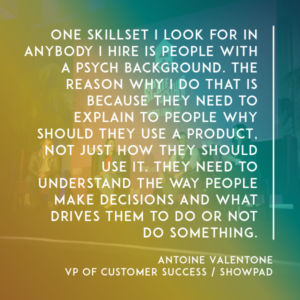
Outside of that, believe it or not, the one skillset that I look for in anybody that I hire is actually, believe it or not, people with psych background, if they study psychology in college. The reason why I do that is because I think, as Annie said, explaining to people why should they use, not just how they should use, and understanding the way people make decisions in their lives, and what drives them to do something or not to do something.
Having that fundamental understanding of people’s decision making processes makes it easier, I think, for someone in a customer success organization to have a conversation in a way where it motivates people to listen and then to take action, so psych majors.
Santiago: Katie, you’re going to get the easy questions. We’re investors in SalesLoft, so she’s going to get all the easy questions.
Katie: You can give me some tough ones. [laughs]
Santiago: You give a great talk where you explain how you started this customer success org and how you expanded it over time and how you started thinking about like a matrix, where people were flowing through different boxes. Can you walk us through your thought process in doing that?
Katie: Absolutely. As SalesLoft grew, within my first year, we’re roughly about 100K when I came on board. By the end of that first year, we’re at a million. Today, we’re at 10 million, just three years later. The growth was really, really quick, to keep it simple.
In that time period, it started out, like you said, with support. That was the initial Jack of all trades, Jane of all trades.
Figuring out the roles that were really key, but also what happened if someone was out? We were an agile team of three, or four, or five. If someone was out from support, would we just fall apart? What would that look like?
I cross-trained our team. We cross-trained together. What were the basic fundamentals of that role? Maybe you don’t need to have the full experience, but could you perform the basic day to day task so our customers were always supported?
That was really, really big for our first year and a half. The teams were really excited because they were learning a variety of different skills. With that foundation of…For us, it was support, onboarding, and then customer success.
They got to really figure out what their passion was. Just like you said, it clearly defined their role within the company years later.
Santiago: Right. This is a question for the panel. What we hear from a lot of our companies is that customer success is not just a small group within the org, that it is to be a state of mind. How do you make sure that everyone is onboard with customer success, not just the customer success org? Who wants to take it?
Annie: I think it takes quite a bit of ongoing dialogue amongst the leadership team. There needs to be alignment at the top. The easiest way to do it…My joke is to align comp plans, so they match up, but not always possible, right?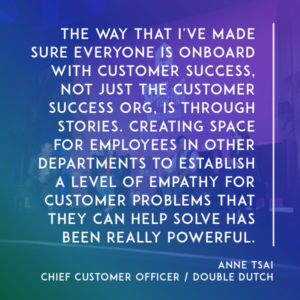
The way that I’ve had to do it and been successful to doing that is through stories, bringing in the subjectivity of stories and creating space for employees in other parts of the company to establish a level of empathy for our customer’s problems that they can help solve, has been really powerful.
I think that’s really the role of the customer executive, in the end.
Antoine: I absolutely agree with you, definitely on the point of the comp plans, comp plans drive behavior, so what you hope to see is someone other than the success leader having some skin in the game and churn being part of how they’re measured and subsequently comped.
What I would add to that is, and you did touch upon this, Annie, is building the relationships with those other leaders that do have an impact on churn.
I’ve always said there’s two different types of customers. There’s external customers that pay you for your product or service, but you have internal customers, and to me, that’s the VP of Sales, VP of Engineering, VP of Product.
Even though they’re not within the customer success organization, their actions have a significant impact on, again, customer success. I want to build relationships with them.
Last year when I spoke with Jason on a panel, he mentioned taking your external customers to steak dinners. I said, “Hey, well, don’t forget to take your internal customers to steak dinners, as well.” [laughs]
You want to really make sure you’ve got relationships with them. You avoid the silos, and that they care about how their actions have an impact on customer success.
Katie: To take that quickly to the next level, just the internal relationships is so important, and being aligned internally.
Something we’ve done at SalesLoft is Oh So Cheesy Lunches. I literally order pizza for two different departments, and we get together once a quarter, whether that be support, product, sales, whatever that may be, but it’s to get everyone who is a part of the customer experience, and that’s everyone in the company. You have to make your way through the company but you have to have those relationships.
It’s been really exciting and the team looks forward to it. It’s cheesy, of course, but it builds those relationships. That way, there’s trust and that’s something we really focus on.
Santiago: When you bring in those customer success teams, how do you measure the teams’ success or performance, and how do you measure each individual, because it’s hard to say, “OK, my customers are happy, happier.” It’s a soft measure. How do you make sure that they’re driving value for the business?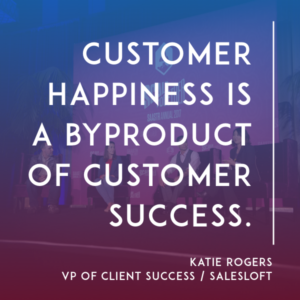
Katie: I always tell my team and they know that we don’t make customers happy, we make them successful. I think Lincoln Murphy said that at some point, but happiness is a byproduct of success.
We’ve been really focused on what does success look like for you with SalesLoft and asking those questions and…you’re talking to a VP of Sale on the other line and that can be intimidating for someone who’s junior in their career.
Really coaching them up, but asking those tough questions upfront to ensure that we’re in alignment with the customer and then continuing to prove that value throughout the entire customer experience.
Santiago: How do you measure that they’re successful?
Katie: We use Gainsight, but we have health scores that measure different factors, whether it’s adoption, product use, different things like that.
Each of the team members that I have have different segments of customers, and so we measure the health of their segment base, the accounts, and a variety of different factors that roll into that. No one CSM has the exact same metric because their books are slightly different.
Santiago: On compensation, how do you like to compensate customer success executives? Is it mostly bonus, is it based on renewals, is it just a base?
Antoine: I’ll take that one first. It’s a mix. There’s a base salary, of course, but then there’s a variable component that is driven by their individual performance. I found, in my experience, anyway, that that drives the right behavior, although I will say that there still is the team aspect of it as well.
Initially, we were compensating our success coaches based on individual patch, health and performance. Irrespective of how their neighbor did, they were eligible to make as much as they could, based on their own individual performance.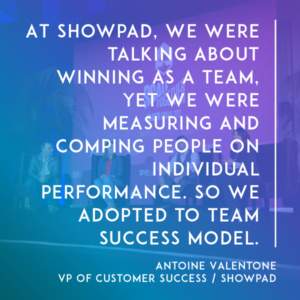
At the same time, we were always talking about winning as a team at Showpad, and it’s something I really do believe in. It dawned upon me that there’s this contradiction. On the one hand, we’re talking about winning as a team, but yet we’re measuring and comping people on individual performance.
What we did recently is we went to more of the team success model, meaning that their variable would be driven by the team success. I have done that in the past, as well. There’s pros and cons to either way, but ultimately, again, it’s intended to drive the right behavior and then get the results that we want. To be determined, how it works out, but so far so good.
Annie: That’s a pretty controversial topic.
[laughter]
Annie: I know there are some companies out there that their entire OTE is structured within base. Historically, I have done base plus variable and the components of variable have been anywhere between a single number, like an NPS type of number, all the way up to five different variables, which is too many.
I have tried to narrow it down to anywhere between one and three, where one of them is team based, and then there are two individual components.
Katie: Something just to keep in mind, when SalesLoft started, we had three CSMs in our first year, and they’re Googling online, what should a CSM get paid? Of course, everything comes from the West Coast, and then X, Y, and Z, “Hey, Katie, I’m not making this much.”
There are levels to CSM comp and how you get started. If you’re starting out in your grassroots, base is OK. You want to get someone in the door and then talk with them about what that looks like. It’s just very interesting. Make sure you’re comparing yourself to other companies at your level, not just Googling a CSM comp.
Antoine: The other thing I wanted to add, by the way, compensation, again, obviously is important. People need to earn a certain amount, I get that, but going back to your initial question about the type of people that I hire, especially in the customer success world, I’m trying to find people that actually have a genuine interest and gain satisfaction from helping others.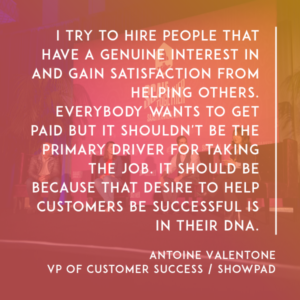
Of course, again, everybody wants to get paid, I get that. It shouldn’t be the primary driver. It shouldn’t be why they’re taking the job. It should be because it’s just in their DNA. They do enjoy helping customers be successful. That’s a big part of it.
I wanted to just point that out, that there are other factors outside of the compensation that should drive the behavior, where they want to win because it just makes them feel good to know that their customers are seeing a tremendous return on their investment using your product or service.
Annie: Just to add one more thing to that, it’s actually more important, I think, to have a definition for what customer success is going to be at your company, and the compensation plan should really be reflected up in that.
This is where the controversy lies, should customer success be responsible for renewal? Should customer success be just an advocate? Should customer success own growth over time, expansion?
Depending on how you’re structuring your customer success org, then that will, I think, play a lot into how you compensate.
Santiago: That’s a great segue to my next question.
A lot of us see customer success as one of the most efficient growth engines within organizations. It’s not just making sure existing customers are successful with existing products, but also how to make them successful with additional product, more features, and that gets us into upsells and cross sells. What are your thoughts? Should customer success own those metrics?
Annie: Where I sit today is that, I think, less around a commission type of structure. I think the type of people that do well in a customer success org, at least the type of people that I’ve hired and interacted with, because I have mostly looked for an advocate type of person, similar to the person who just wants to naturally help others.
If they’re not naturally oriented towards the commercial side of driving revenue, then it’s going to be very hard for them. It’ll paralyze them to have a quota. I imagine that has probably biased how I think about it.
Santiago: Different opinions here?
Katie: Torn, I work for a sales company, on that regard.
I do believe and we’re toying with the CSM in a type of revenue role, whatever, that’s renewals and expansion rep. I don’t have it coined out yet, but I do believe that the CSM should be the advocate, driving adoption, driving health. We’re going through the midst of figuring out who owns those heavier numbers in the expansion.
When you think about them, they are two different skillsets, at the end of the day. I’ve been in sales, I know what it takes to get a larger deal closed.
We’re not talking about order taking. “Hey, I need to add two users, we’re growing,” or something like that. We’re talking about competitive sales. I really fundamentally believe that they’re two different roles, personally.
Antoine: If I can add to that, clearly sales owns the quota, but definitely the customer success organization has to be a willing partner with sales to help make those growth opportunities happen.
It’s a very delicate balance you try to strike within your customer success organization where you want to act as trusted advisers, consultants. You’re creating awareness around all the wonderful additional value that customers can extract from the solution, but it should feel organic to the customer where they don’t feel like they’re being sold as opposed to where customer success is just driving the blue light special in order to hit a quota.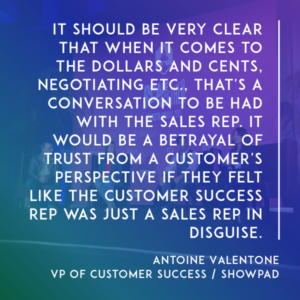
That would be a betrayal of trust, I think, from a customer’s perspective, and then they would maybe be less willing to talk to a customer success person because they feel like they’re sale reps in disguise.
I would say customer success definitely be willing to partner with sales, but it should be very clear to the customer that when it comes to the dollars and cents, negotiating etc., that’s a conversation to be had with the sales rep.
Santiago: How do you manage those hand off? You have a sales rep closes a deal, then customer success gets involved, they identify opportunities, and they need to bring in the sales rep again?
Katie: I’ll take it. At SalesLoft, it’s definitely been a journey we’re exploring. Initially, we’ve kept it in house, and usually I’m the one negotiating with our customers and our CSMs are advocating heavily for them. The customer really, truly feels that. Now, we’re starting…
[crosstalk]
Santiago: You’re negotiating with a customer to close a deal, then upsell?
Katie: Not a new deal, an upsell of some kind.
Santiago: Do you have a quota?
Katie: I do not as of today. There are goals that we’d like to hit.
I think what naturally comes about in SalesLoft, within our team, our customers are organically growing on their own because the teams are advocating in the right way, saying, “Based on what we talked about last week, it sounds like you might need X, Y, and Z. This is on our enterprise plan, here’s the cost. Not force feeding at all, but I want to make you aware that we have this and I’m actively listening to better support your business.”
The upsell, if you will, naturally happens because they’re advocating and not force feeding something. We found that our customers are just open to the growth because of the way we’re presenting it. There’s not really a hard sell, if that makes sense.
Antoine: Agree with you there. Again, it should feel very organic. It’s more like, “Oh, that sounds wonderful. Of course, I want that. Send me an order form and I’ll sign it.” In that case, the account executive doesn’t necessarily need to be involved.
There’s other cases where there’s a larger expansion, more complex sales cycle etc., etc. In that case, it might be a partnership between the sales rep and the customer success coach, or the AE just might take the lead and run with it. If done correctly, it’s just very organic and it just happens, which is nice.
Annie: It’s also, I think, going to depend a lot on how the revenue comes in. As a scenario, for instance, you could be selling flat subscriptions on flat renewals, and then be introducing new products. That may require someone with more of a commercial side in order to come in and be pitching as a specialist to a product.
If you are selling the same licenses within a centralized buyer and that buyer is a champion internally within the organization that you’re selling into, it’s possible that customer success can retain the advocacy side and drive expansion at the same time.
However, if you’re selling in a fragmented manner, for instance, you’re selling to HR and then you’re selling to marketing, and then you’re selling to sales, and you have to be pitching every single time in order to get that deal done, that’s a different type of expansion and you probably require someone with more of a commercial side.
Santiago: When you’re working with your customers and you’re trying to make them successful, how do you think about throttling the level of customer success so that it doesn’t become like professional services that you’re not charging for?
Katie: I think it’s making sure that as they come onboard, that you’re setting the expectations of what your team will do, how involved we will be and what their expectations are. You have to lay out a mutual agreement when you’re starting, at the beginning of a relationship. For us, it’s just been really clear.
Certain times, customers will need more and they’ll say, “Hey, we need more.” We don’t have professional services at this time. Could I see that happening? Yes, but we’ve really worked with our product team, as well, to say, “Hey, customers need more time in these two or three areas.” They’ve actually been able to innovate quite quickly on the product because of that.
Again, that goes back to really deep bonds internally, having that trust and that communication.
Annie: That’s great, good for you.
Katie: Thanks.
[laughter]
Annie: That’s awesome. Everybody, do that.
I think on the customer side, what is really hard for us is to deliver the startup type of customer success, which is do whatever it takes to get the deal done and deliver the commitments but to do it in a margin positive way.
You really need to think about segmenting your customer base in a way that affords the company the ability to focus people resources on the highest value opportunities and customers.
I’ve seen a lot of companies, DoubleDutch included, as well as Demandforce prior, as one of them as well, that have invested in a layer of customer marketing, invested in a layer of customer success programs, so they can offset the burden of the lower margin deals or negative margin deals because you have to.
Santiago: Most of the times when we’re looking at enterprise companies, we look at the customer success function, and we include it in variable costs. Should it be a cost, or should it be a revenue driver?
Katie: I want to give that to these two.
Antoine: To me, ultimately, it’s a revenue driver. Sure, there’s cost associated to this, cost is associated to everything, I think there has to be a fundamental understanding and willingness for a customer success to play ball, again, with sales, to grow these accounts, if possible, extract the most value, but again, doing so very delicately whereas not to betray the customer’s trust, where they feel that the customer success is just part of the sales function. Ultimately, to me, it is ultimately about bringing in more dollars.
Annie: Yeah, we put a percentage in COGS and a percentage out of COGS, too.
Santiago: It’s a revenue driver. Does it need to carry a quota?
Antoine: Certainly, there’s a retention quota, being the most obvious, and then sprinkle on top of that… The way we look at is from two main KPIs, and number one is gross churn. We know that we set a target we don’t want to lose X amount per year, and then we set a net target for the customer success coaches. Again, they are compensated on this as well.
Let’s make up for what we lost and then let’s still grow the installed base. Ultimately, yes, there is growth associated with their compensation and targets.
Santiago: Let’s switch a little bit to tools and platforms that you love, and tools and platforms that you think are overrated.
[laughter]
Antoine: Gainsight’s probably the fan favorite, and I personally enjoy using it. It’s had a tremendous value. You’re using Gainsight, as well?
Katie: Recently. A startup, back in our first year, you had to be pretty scrappy, and so tools that were just effective from a CSM standpoint. If you’re scaling your business, Mouselight you can find on the Apple Mac Store, it’s 99 cents. As you’re giving presentations to your customers, you can talk about the elevation of cost as you grow as a business, Gainsight obviously is here, not here, but I can talk small little hacks all day with tools and apps.
Santiago: Talk about those hacks.
Katie: Mouselight. aText is 99 cents, best 99 cents I’ve ever spent in my life. It’s a text expander, so instead of writing SalesLoft every single time, I write SL1. Boom. Those are my top two, I’ll end there.
Annie: I’m a fan of Gainsight too, but in the early days, I was really into the idea of building out a 360 view inside Salesforce, because that was the sales tool of choice. It was really important for me to make sure that the customer success managers were connected and the data that they were inputting was connected to what the sales people were saying.
Ended up building out, probably a percentage of the stuff that Gainsight can do in Salesforce itself. Once we were able to make an investment in a real tool that was really focused on customer success, we went there.
Antoine: For me, outside of Gainsight, there’s Salesforce obviously, and then Zendesk. I intentionally try to limit it to not much more than those tools, not to add complexity. Too many tools just leads to things getting lost in translation. For me, I’m pretty happy with that stack.
Santiago: On the overrated tools? You don’t need to talk about specific companies, but have you tried anything that you feel, “Oh, it’s just a buzzword”?
Antoine: My personal pet peeve is some of this…I get these emails and they’re like, “Hey, I know you’re looking at my email, why don’t you respond?”
[laughter]
Antoine: I want to respond and say, “I’m only looking at it long enough to figure out that it’s not something I’m interested in,” and then I delete it. It’s like a false positive, it’s like, “Yes, I’m looking at your email, but it doesn’t mean that I’m actually interested in your product or service.”
Katie: That’s the wrong way to do that, by the way, because SalesLoft will help you notify, “Hey, you’ve read my email.”
[laughter]
Katie: That is the wrong way to go about that, so just from a company standpoint, you don’t say, “Hey, you’ve read my email. Let’s chat.” It’s super creepy.
Antoine: I never heard that from SalesLoft, absolutely not.
[laughter]
Katie: Thank you.
Santiago: One company and one CS leader that you follow?
Antoine: You mean aside from Nick? Can’t say. Catherine Blackmore…Sorry to interrupt you.
Katie: Yeah, in the early days.
Antoine: They’re on the other stage at the moment. [laughs]
Katie: I’d say Dave Blake with ClientSuccess. Super genuine and very knowledgeable about his time with Adobe.
Santiago: Other companies that are doing a great job with customer success?
Antoine: It’s interesting. Customer success, it’s new. It’s evolved, it used to be customer service etc., and it continues to evolve. Some organizations, maybe they haven’t tried it yet or maybe they’ve been doing it for a while, but I think it’s an evolution. I think, just based on the educated buyer, there’s a different experience that customers want when interacting with a service provider.
My personal opinion, looking out into the future, my thought is that whether it’s a new prospect considering buying for the first time or repeat business, the customer success mindset and mentality and philosophy as far as approaching value added conversations, is really I think what the consumers are looking for. It’ll continue to evolve and get even bigger.
Katie: It’s interesting about customer success, because you always look online for blogs and posts. We’re too busy.
Sometimes, we’re just too busy. I’d love to be able to see just more writing and all of that. When you think about it, more often than not, we’re heads down. When do you come up to breathe? You’re with your team.
I think, across the customer success realm, I’d love to see different levels, communicating more about their strategies, what they’re doing, where they’re failing, and how they’re improving.
Annie: I think a lot of good work has come out of larger companies or more established SaaS companies. LinkedIn, I think has a pretty good SaaS program, but they also have a lot of the right components to drive a good success program.
For instance, they have this parallel programming of account management and customer success. They also have multiple products that they can sell into different buyers, but also expanding with existing buyers. Those are nice formulas for customer success to thrive.
Santiago: Now let’s switch a little bit and let’s go into the future, I mean the future of customer success. Now, everything is going to be artificial intelligence, machine learning, chatbots, so how do you think this function is going to evolve over time? Paint a picture of the next five years.
Antoine: I’ll add to my previous answer, I think one of the fundamental differences is getting to the point where you feel comfortable as a customer success person, challenging the customer.
I think there’s a false perception that customer success is the same thing as customer service where you just blindly do whatever the customer wants because they asked and the customer’s always right. When in reality, we know the customer’s not always right.
I think you would be doing them a disservice if you just blindly followed orders.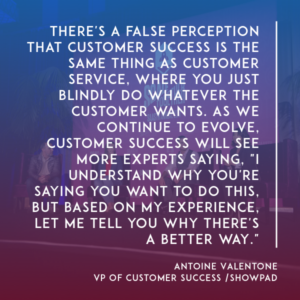
I think, as we continue to evolve, customer success will become more of challenges where experts feel comfortable in a diplomatic way, saying to the customer, “Well, look, I understand why you’re saying you want to do this, but based on my experience, let me tell you why there’s a better way.”
I can tell you from having done that with customers, they really appreciate when you talk them off the ledge and prevent them from doing something that ultimately would’ve hurt them. Again, to me, customer service is you just do what they say because you don’t want to piss them off. Customer success is, “I hear you, I understand why you’re asking that, but let me show you a better way.”
If you do it right, then you’re really driving value, and you take the relationship beyond the typical customer-vendor and it becomes more of like a partnership.
Annie: Customer success today in an organization that I think is functioning well is really the intersection of revenue, and marketing, and product, and service. It’s taking bits of each of those parts and I think really advocating for the customer within the scope of that. Over time, I think it pulls up, which is really doing only the things that people can do.
There’s a lot of stuff that customer success managers do that is really making up for product deficiencies, which is fine. In early startups, that’s what you need to do because you’re iterating fast, but as the company matures, you really need to pull up those human resources.
I really believe in this layer of programmatic customer marketing that will support and drive the conversation and prepare the customer to engage with people when the time comes, when it’s the right time to do that.
Santiago: How would that work? Can you elaborate a little bit more on that?
Annie: Yeah, you can use a mix of Gainsight, you can use Marketo, you can use any marketing automation type of tool, but it’s really about taking all of this stuff, as well as the data that you have on your customer and preempting. You guys probably have the data on when someone is calling in for a particular problem.
You can trigger communications to go out through your email channels, through your product, if you’re chatting with them, through chat, how to address that before they typically ask that type of question.
That also is customer success because it gives you the ability to connect with the customer, a person to connect with that customer, and spend time having a value added conversation as opposed to, “This is how you fix this problem.”
Katie: I think less admin work for our teams, they will actually be able to have more face time with customers, more knowledgeable conversations, adding more value, we’re going to be smarter.
All of the technology that’s coming out today, it’s going to just enhance the overall customer experience, and internally from a company level, we’re going to be able to be connected.
I think that’s what customer success, we’re starting to see today, companies really thriving when they embody it. Everyone’s connected, everyone’s in mind with the vision to serve the customer, and they know where they play a key part in that role. I think we’re going to get faster, we’re going to have even better customer experiences, and it’s going to be a connected internal experience.
Santiago: Nobody talked about machine learning, do you think that’s going to have a role in customer success?
Katie: I can’t imagine it wouldn’t. It’s hitting all other aspects of the business. It would seem silly if we didn’t use it to our advantage and to learn from it.
Santiago: In the interest of time, one final thought for the audience, something that changed your life as you were doing customer success, thinking about teams, thinking about your organizations.
Annie: If you’re all early stage, customer success is absolutely something to invest in early, as early as you can, because you need someone at the table who is thinking about the customer all the time. By making that investment, you’re going to have that resource. It’s worth it.
Antoine: For me, it’s V2MOMs, something I learned at Salesforce, instilled at Showpad very early on from the beginning. Create a vision and values and communicate those to your people in a way where they’re willing to make it their own.
Katie: For me, it’s all about the customer, and so having those relevant conversations often with your team and making it about the customer and not about their role, why they’re here, and having those conversations more often than not, it really changes how you serve as a company.
Santiago: Thank you very much. Help me thank the great panelists here.

